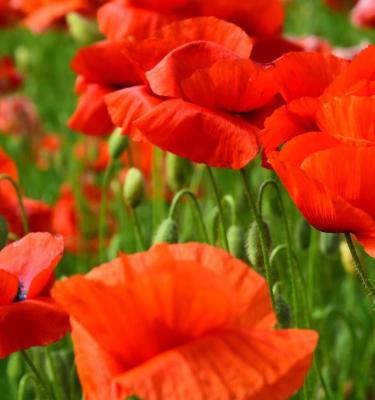

How to Grow & Care for Poppy Flowers
Poppies will bring a flush of colour into your spring garden with their frilly flowers. There are many different types of poppies and although many prefer a cooler climate, they can be grown in most regions around Australia if you choose a type and planting time to suit your climatic zone.
If you’re new to growing poppies try Iceland or Californian types as they will happily grow in all climates.
4 top tips for growing poppies
- Poppies are easily grown from direct-sown seeds or seedlings.
- Sow or plant poppies in the cooler months for colourful displays of flowers in 3-4 months later
- Flanders Poppies (Papaver rhoeas) are the traditional Remembrance Poppy. Sow around ANZAC day (April 25th) for flowers around Remembrance Day (November 11th).
- Fertilise poppies in late winter or early spring with Scotts Osmocote® Controlled Release Fertiliser: All Purpose for healthier plants and more blooms.
Essential shopping list for growing poppies
- Poppy seeds or seedlings
- Scotts Osmocote® Controlled Release Fertiliser: All Purpose
- Scotts Osmocote® Compost Premium Soil Improver
- Garden Shovel
- If growing in pots, you’ll need Scotts Osmocote® Premium Potting Mix + Scotts Osmocote® Controlled Release Fertiliser for Pots and Planters and a suitable pot or container
- If growing from seeds in pots you’ll need Scotts Osmocote® Seed & Cutting Mix
- Defender™ Snail & Slug Pellets
Preparation
Poppies prefer a full sun spot with a free draining soil. Prepare the soil before planting by mixing Scotts Osmocote® Compost Premium Soil Improver through the top 10-20cm of soil.
Planting poppy flowers in the garden
Growing poppies from seeds:
To grow poppies from seed, sow poppy seeds directly into prepared ground or punnets filled with Scotts Osmocote® Seed & Cutting Mix. The seeds should be sparingly sprinkled on the soil or potting mix surface and very lightly topped with a dusting of soil or potting mix - don’t bury the seeds too deeply as they need some light to germinate.
Keep the soil moist while the seeds germinate, using a fine spray from your hose or sprinkler. Poppy seeds will take around 10-20 days to germinate. Once the seedlings grow up they can be thinned to allow 15-25cm between seedlings (depending on the variety).
Protect the young poppy plants from slugs and snails by using beer traps (saucers filled with beer placed on the ground) or sprinkle some Defender™ Snail & Slug Pellets around.
Growing poppies from poppy seedlings:
Plant poppy seedlings into prepared soil as above, allowing 15-25cm between seedlings (depending on the variety). Poppy seedlings don’t like root disturbance, so take care not to disturb the roots too much.
Water in well and protect tender new growth from slugs and snails with beer traps or Defender™ Snail & Slug Pellets.
Growing poppies in pots
Poppies can be grown in small to medium pots or planters with good drainage - choose a pot that is at least 20-30cm deep and about the same width.
Fill your pot or planter with Scotts Osmocote® Premium Potting Mix and plant poppy seedlings (at the recommended spacing for your chosen variety) or sow seeds following the instructions above.
Fertilise potted poppies with Scotts Osmocote® Controlled Release Fertiliser for Pots and Planters in late winter or early spring.
Poppy flower fertilising & care
Fertilise poppies in late winter or early spring to encourage strong healthy plants and lots of blooms with Scotts Osmocote® Controlled Release Fertiliser: All Purpose at the recommended rate.
Remove spent flowers at the base of the stem to encourage further blooms. Poppies make a great cut flower if you pick them just as the bud opens - they’ll open fully indoors and last well in a vase.
Once your poppies have finished flowering, cut off the dried seed heads and put them into a paper bag. Once they’ve released their seeds you can save them to replant the following year.
Some types of poppies self seed very easily - take care when planting near native bushland and remove seed heads before they disperse.
When to sow poppy seeds and poppy seedlings
Cool climates: sow summer to early autumn
Temperate climates: sow in autumn
Tropical and subtropical climates: sow early autumn to winter
Common poppy flower pests
Keep slugs and snails from eating poppy foliage and flower buds by placing beer traps around plants or sprinkle Defender™ Snail & Slug Pellets at the base of each plant.



